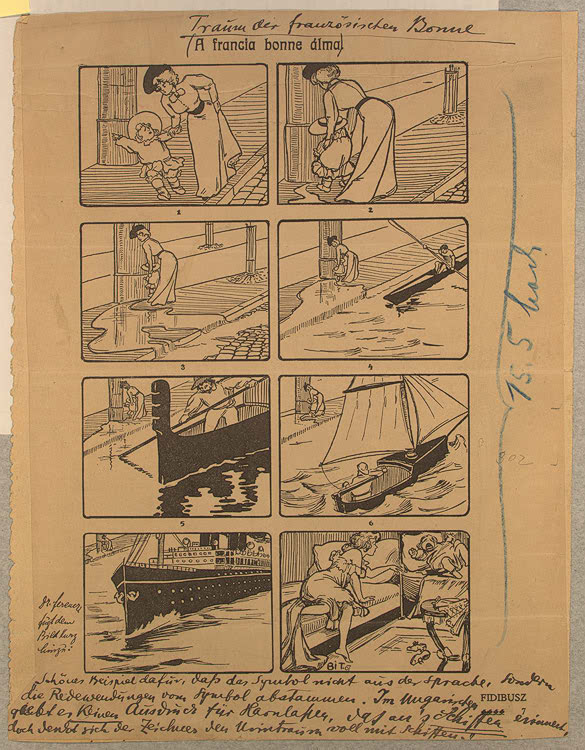|
The Sun (wordless Novel)
''The Sun'' (french: Le Soleil) is a wordless novel by Flemish artist Frans Masereel (1889–1972), published in 1919. In sixty-three uncaptioned woodcut prints, the book is a contemporary retelling of the Greek myth of Icarus. Told with high-contrast black-and-white art with bold linework, the book's protagonist is a little man who leaps from the imagination of his sleeping creator. The little man repeatedly tries to find his way to the sun, climbing towers, trees, and a staircase of clouds before his success sends him plummeting back to earth—and his creator. Masereel was the first wordless novelist, and ''The Sun'' followed on the success of Masereel's first works in the genre, ''25 Images of a Man's Passion'' (1918) and ''Passionate Journey'' (1919). A young Lynd Ward read a copy of ''The Sun'' while studying wood engraving in Germany, and the book was an influence of the American artist making wordless novels of his own, beginning in 1929 with ''Gods' Man''. Synopsis A ... [...More Info...] [...Related Items...] OR: [Wikipedia] [Google] [Baidu] |
Frans Masereel
Frans Masereel (31 July 1889 – 3 January 1972) was a Flemish painter and graphic artist who worked mainly in France, known especially for his woodcuts focused on political and social issues, such as war and capitalism. He completed over 40 wordless novels in his career, and among these, his greatest is generally said to be '' Passionate Journey''. Masereel's woodcuts influenced Lynd Ward and later graphic artists such as Clifford Harper, Eric Drooker, and Otto Nückel. Biography Upbringing Frans Masereel was born in the Belgian coastal town Blankenberge on 31 July 1889, and at the age of five, his father died. His mother moved the family to Ghent in 1896. She met and married a physician with strong Socialist convictions, and the family together regularly protested against the appalling working conditions of the Ghent textile workers. Education At the age of 18 he began to study at the École des Beaux-Arts in the class of Jean Delvin. In 1909, he visited England a ... [...More Info...] [...Related Items...] OR: [Wikipedia] [Google] [Baidu] |
Kurt Wolff (publisher)
Kurt Wolff (3 March 1887 – 21 October 1963) was a German publisher, editor, writer, and journalist. Wolff was born in Bonn, Rhenish Prussia; his mother came from a Jewish-German family. He married Elisabeth Karoline Clara Merck (1890–1970), of the Darmstadt pharmaceuticals firm, in 1909. Together with Ernst Rowohlt, Wolff began to work in publishing in Leipzig in 1908. He was the first to promote and publish Franz Kafka and Franz Werfel but declined to publish the works of Axel Munthe. Wolff's close contact to other writers in Prague and the support for unknown, but talented writers, helped him develop Kafka's friends, Max Brod and Felix Weltsch, who were more well known in Berlin and Germany. In 1929, Wolff published the photography book ''Face of Our Time'' by August Sander. In 1941 Wolff and his second wife, Helen Mosel, left Germany and emigrated to Paris, London, Montagnola, St. Tropez, Nice, and finally with the assistance of Varian Fry, to New York City. Late ... [...More Info...] [...Related Items...] OR: [Wikipedia] [Google] [Baidu] |
Pantomime Comics
Silent comics (or pantomime comics) are comics which are delivered in mime. They make use of little or no dialogue, speech balloons or captions written underneath the images. Instead, the stories or gags are told entirely through pictures. Definition Silent comics have the advantage of being easily understandable to people - like children - who are slow readers. The genre is also universally popular since translation is not required, lacking the usual language barriers. Sergio Aragonés, a famous artist in the field, once said in a 1991 interview with Comics Journal: "What happens is like a supersimplification. Something you can say with words, you have to eliminate all the words until it can be told in a little story without words. You just think a little longer. But it becomes rewarding in the end because everybody can understand your cartoons no matter what your nationality. And that, to me, has been always a big thing—to do cartoons that everybody can understand, every age, ev ... [...More Info...] [...Related Items...] OR: [Wikipedia] [Google] [Baidu] |
1919 In Comics
Events January * January 1 ** The Czechoslovak Legions occupy much of the self-proclaimed "free city" of Bratislava, Pressburg (now Bratislava), enforcing its incorporation into the new republic of Czechoslovakia. ** HMY Iolaire, HMY ''Iolaire'' sinks off the coast of the Hebrides; 201 people, mostly servicemen returning home to Lewis and Harris, are killed. * January 2–January 22, 22 – Russian Civil War: The Red Army's Caspian-Caucasian Front begins the Northern Caucasus Operation (1918–1919), Northern Caucasus Operation against the White Army, but fails to make progress. * January 3 – The Faisal–Weizmann Agreement is signed by Faisal I of Iraq, Emir Faisal (representing the Arab Kingdom of Hejaz) and Zionism, Zionist leader Chaim Weizmann, for Arab–Jewish cooperation in the development of a Jewish homeland in Palestine (region), Palestine, and an Arab nation in a large part of the Middle East. * January 5 – In Germany: ** Spartacist uprising in B ... [...More Info...] [...Related Items...] OR: [Wikipedia] [Google] [Baidu] |


